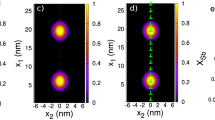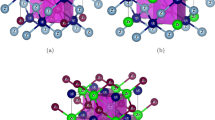Abstract
Concerning the parabolic oxidation of alloys with a low content of a different valence element, we show that the Wagner-Hauffe valence approach contains some inaccuracies. This paper is devoted to the growth of an oxide MO with metal excess or oxygen deficit. The analytical processing consists in solving the differential equation connecting the point defect flux to the oxygen pressure. This equation has been solved analytically in the case where the foreign-element concentration is very high compared to that of the point defects in the pure oxide. On this assumption with a lower-valence dopant, as long as the oxide conductivity remains essentially electronic, the oxidation is limited only by the transport of ionic defects across the scale under the electric-potential gradient. Moreover, an increase of the dopant concentration may lead to an oxide exhibiting partial ionic conductivity. Consequently, the parabolic constant variations as a function of the dopant concentration is not monotonic, contrary to results published before. With a higher-valence dopant, the conductivity always remains electronic, and this result agrees with predictions based on the Wagner Hauffe approach, though the demonstrations are fundamentally different.
Similar content being viewed by others
References
K. Hauffe,Oxydation von Metallen and Metallegierungen (Springer Berlin, 1957)
K. Hauffe,Oxidation of Metals (Plenum Press, New York, 1965), p. 176.
P. Kofstad,High Temperature Oxidation of Metals (Wiley, New York, 1966), p. 265.
G. C. Wood,Oxid. Met. 2, 11 (1970).
S. Mrowec and T. Werber,Gas Corrosion of Metals, p. 164. Translated from Polish. Published for the National Bureau of Standards and the National Science Foundation, Washington, DC, by the Foreign Scientific Publications Department of the National Center for Scienctific Technical and Economic Information, Warsaw, Poland, 1978).
D. Landolt,Corrosion et Chimie de Surface des Métaix, (Presses Polytechniques et Universitaires Romandes CH-1015, Lausanne, 1993), p. 331.
P. Kofstad,Corros. NACE 24, 379 (1968).
P. Kofstad,Nonstoichiometry Diffusion and Electrical Conductivity in Binary Metal Oxides (Wiley, New York, 1972), p. 106.
F Gesmundo and F. Viani,J. Electrochem. Soc. 128, 470 (1981).
P. Kofstad,High Temperature Corrosion (Elsevier Applied Science, London, 1988), p. 169.
C. Wagner,Atom Movements (American Society of Metals, Cleveland, 1951), p. 153.
N. Cabrera and N. F. Mott,Theory of the Oxidation of Metals, Rept. Progr. Phys. 12, 163 (1948–49).
F. Kröger,The Chemistry of Imperfect, Crystals, vol. 3, 2nd ed. (North-Holland/American Elsevier, 1974).
F. Gesmundo and F. Viani,J. Electrochem. Soc. 128, 460 (1981).
Author information
Authors and Affiliations
Rights and permissions
About this article
Cite this article
Sarrazin, P., Galerie, A. & Caillet, M. Contribution to the understanding of the parabolic oxidation mechanism of dilute alloys. Part I: Oxides with metal excess or oxygen deficit. Oxid Met 46, 1–17 (1996). https://doi.org/10.1007/BF01046881
Received:
Revised:
Issue Date:
DOI: https://doi.org/10.1007/BF01046881




